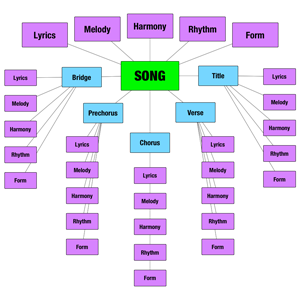-
Revision as of 05:07, 16 November 2010 by Grahamenglish (Talk | contribs)
Lyric Writing Checklist
Songwriting Infobox 
Song ModelSongwriting Lyrics - Melody - Harmony - Rhythm - Form Song Form Title - Chorus - Verse - Prechorus - Bridge Lyric Infobox Lyrics: Top Level Title - Song Plots - Rhyme - Rhyme Scheme - Lyric Triad Patterns - Lyric Writing Checklist - Scratch - RhymeZone - Titles - Category:Lyrics - Template:Rhyme - Template:Lyric Lyric Lyric - Melody - Harmony - Rhythm - Form A To Do List For Writing Lyrics To Music
- Identify the Song Form.
- How many sections are there?
- What is their relationship?
- Which sections repeat and which ones change?
- Identify the Musical Hook.
- If there is a chorus, where does the musical hook appear? How many times? If it is a verse/refrain, is the musical hook at the beginning or the end of the verses?
- Write Dummy Lyrics that Fit the Hook Perfectly.
- See what shape it has—where the stressed and unstressed syllables go. Make sure the mood and tone of your dummy hook fits the mood and tone of the music. DO NOT MISTAKE YOUR DUMMY HOOK FOR THE REAL TITLE.
- Find a Great Title that Matches the Shape of the Dummy Title Perfectly.
- The title should be:
- Interesting and engaging
- Repeatable. That is, able to lend itself to continuing development as the lyric's sections progress.
- The title should be:
- Locate the Stressed Syllables in the Title.
- Using their vowel sounds, go to the rhyming dictionary and brain- storm for ideas. Figure out what the song will be about, and maybe some of the images, characters, settings, etc., that might be useful.
- Make a Rough Sketch of How the Ideas Will Develop from Section to Sec- tion to Set Up the Title.
- If There Is a Chorus, Scan the Melody for Stressed and Unstressed Posi- tions. Write a Draft of the Chorus.
- After You Finish Your Draft Chorus, Or If There Is No Chorus, Scan a Verse for Its Stressed and Unstressed Positions, and Write a Dummy Verse, Making Sure that the Syllables Match the Notes Exactly.
- Since you have some idea what you're writing about, some of the phrases you come up with may actually stick, but don't count on it. This is just to make sure the syllables fit the melody. Don't fall in love with any of your lines yet.
- Identify Matched and Unmatched Phrases to Determine Where Rhymes Might Work Best.
- Be sure to plan rhymes for the ends of each section. Experiment with a few different rhyme schemes to see how flexible the music is. Pay no attention to WHAT you're saying, yet. You're simply looking for rhyme placement here. You'll need all the flexibility you can get, when you actu- ally have to say what you mean—and rhyme, to boot.
- Write the First Verse.
- If you're moving into a chorus, be sure the last verse line sets up the chorus and the title clearly. You might even try writing the setup line (last verse line) first, and working backwards. Continue to check for pros- ody: does the shape of the words match the shape of the melody perfectly? If not, go back and rewrite. NEVER MIS-SET A WORD just because it says what you mean. It won't communicate that meaning effectively anyway, if it's mis-set. Find a way to say exactly what you mean, and set it perfectly.
- Sing Through the Verse and the Chorus.
- Does the verse set up the chorus effectively? Are there any lines in your chorus draft that need tweaking?
- Write the Remaining Verses.
- Make sure they match the melody perfectly too. Do they move the lyric idea forward? Is the setup line effective at moving into the second chorus? Sing it through. Tweak some more.
- Scan the Bridge (If There Is One), and Write Dummy Lines that Fit Per- fectly.
- Then find a wonderful contrasting idea, and write the bridge. Again, make sure the setup line enters the final section with the meaning you want.
- Sing it Through. Any Winces? Fix Them.
- Sing it Again. Wrestle it to the ground until it stops moving.
- Identify the Song Form.
-
Meta
